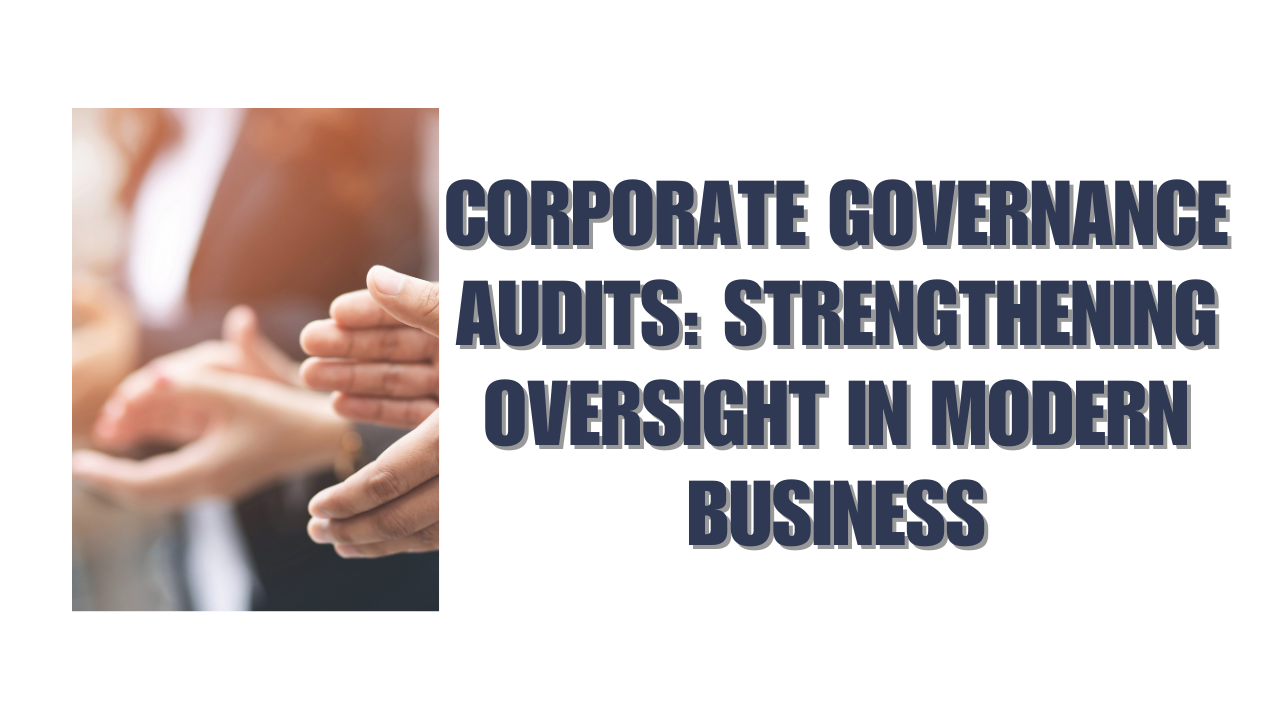When we talk about corporate governance, most people think of rulebooks, board charters, and compliance checklists. But at its heart, governance is really about trust-trust between leadership, shareholders, and stakeholders that decisions are made thoughtfully, transparently, and with the company’s long-term health in mind. And the best way to test that trust? A corporate governance audit.
A corporate governance audit isn’t just another box to tick. It’s a structured check-up that tells you if your leadership structures, accountability mechanisms, and decision-making processes are working as intended-or if they’re quietly leaving gaps that could become costly problems. In today’s world, where investors, regulators, and the public are watching more closely than ever, these audits are far from optional-they’re strategic.
Let’s take a closer look at why corporate governance audits matter, how they work, and how they can help your business not just survive but thrive.
Why Corporate Governance Audits Matter
Think of a corporate governance audit like a health check for your organization. You wouldn’t ignore warning signs in your own body, so why ignore them in your business? Weak governance doesn’t just risk compliance violations-it exposes the company to operational inefficiencies, reputational damage, and missed opportunities.
A governance audit helps:
- Spot hidden gaps: Are board decisions really aligned with strategy? Are policies applied consistently across departments?
- Boost confidence: Investors and stakeholders feel reassured when your governance framework is clear, strong, and transparent.
- Reduce risks: Early identification of weaknesses prevents small issues from snowballing into crises.
In short, a corporate governance audit transforms abstract rules into actionable insights. It’s your chance to see governance in action and understand where improvements matter most.
Breaking Down a Corporate Governance Audit
A thorough governance audit goes beyond compliance. Here’s what it typically looks at:
1. Board Structure and Effectiveness
A board isn’t just a collection of names on a document-it’s the brain of your organization. An audit checks whether the board has the right mix of skills, experience, and independence. Questions it asks include:
- Are directors adding real value?
- Is there enough diversity of thought?
- Are meetings focused, well-prepared, and outcome-driven?
It’s about making sure decisions are informed and not just procedural.
2. Risk Management and Internal Controls
Every business faces risks-financial, operational, reputational, and even cyber. Governance audits dig into how your organization identifies and manages these risks. They examine:
- Internal control systems
- Risk appetite statements
- Crisis management procedures
A solid framework means that when something unexpected happens, your company is ready-not scrambling.
3. Policies and Compliance
Policies are only as good as the people who follow them. Audits look at:
- Codes of conduct and ethics
- Whistleblower and reporting mechanisms
- Anti-fraud and anti-corruption procedures
The goal is to ensure your policies are more than words-they guide daily actions and decisions.
4. Reporting and Transparency
An audit isn’t just about what gets done behind closed doors. It also evaluates how information flows to stakeholders:
- Are financial reports accurate and timely?
- Are decisions communicated clearly?
- Do shareholders and boards have what they need to make informed choices?
Transparency builds trust, and audits shine a light on where it may be lacking.
5. Performance Evaluation
Finally, governance audits assess performance-both of the board and management. Are decisions driving results? Are roles clear? Are executives and directors held accountable? This evaluation ensures governance isn’t static-it’s active, effective, and aligned with business goals.
Tools and Techniques to Make Audits Work
Executing an audit can feel overwhelming, but having the right approach makes a huge difference. Some practical techniques include:
- Structured frameworks: COSO or King IV provide standard measures for assessing controls and governance.
- Checklists and questionnaires: They help auditors systematically capture both qualitative and quantitative data.
- Data analytics: Modern tools can sift through mountains of operational and financial information to reveal trends or anomalies.
- Benchmarking: Comparing governance practices to industry standards highlights gaps and opportunities.
- Interviews and observations: Talking with directors and executives, and observing meetings, uncovers the real dynamics behind the policies.
Think of it like detective work combined with strategy consulting-the goal is insight, not just compliance.
Real Benefits You’ll See
If you approach corporate governance audits correctly, the benefits go well beyond ticking regulatory boxes. Organizations report:
- Stronger stakeholder confidence: Investors and partners know that governance is robust, not just theoretical.
- Better decision-making: Boards make smarter, faster, and more informed choices.
- Risk mitigation: Weak spots are discovered early, before they become crises.
- Operational clarity: Clear roles, responsibilities, and reporting streamline operations.
- Strategic alignment: Governance supports long-term goals instead of just checking compliance.
When executed thoughtfully, governance audits become a competitive advantage-one that signals resilience, transparency, and foresight.
Overcoming Challenges
No process is perfect. Common challenges include:
- Incomplete data: Governance is often spread across systems and documents.
- Stakeholder resistance: Directors or executives may view audits as intrusive.
- Complex regulations: Different jurisdictions or industries require nuanced approaches.
- Capturing qualitative aspects: Governance isn’t only numbers; culture and decision-making styles matter too.
The solution? Clear objectives, early engagement, structured frameworks, and digital tools to bring everything together.
Best Practices for Maximum Impact
To make audits genuinely valuable:
- Be intentional about scope: Focus on areas that matter most strategically.
- Engage the board and management early: Their buy-in makes audits smoother and more insightful.
- Use proven frameworks: Standardized approaches ensure nothing critical is missed.
- Prioritize actionable insights: Recommendations should be practical, measurable, and realistic.
- Make audits regular: One-off reviews can’t create lasting change.
- Leverage technology: Analytics, dashboards, and workflow tools make audits more efficient and insightful.
Audits done this way don’t just uncover issues-they guide transformation.
Turning Governance into a Strategic Advantage
Companies that embrace governance audits as a strategic tool-not just a compliance requirement-gain:
- Investor confidence: Transparent governance reduces perceived risk.
- Reputation protection: Sound governance strengthens credibility with customers, partners, and regulators.
- Proactive risk management: Issues are spotted before they escalate.
- Board effectiveness: Directors understand their roles better and make more informed decisions.
It’s about turning governance into something that actively drives business success, not just paperwork.
Conclusion
Corporate governance audits are more than formalities-they are powerful tools for insight, improvement, and strategy. They reveal where your governance is working and where it isn’t, transforming abstract policies into actionable intelligence.
When done well, these audits give boards and executives the confidence to lead decisively, investors the assurance that the company is well-managed, and employees the clarity to act within a trustworthy framework.
In modern business, strong governance isn’t optional. It’s the foundation for growth, resilience, and credibility-and a corporate governance audit is the first step toward getting it right.
FAQs
1. What exactly is a corporate governance audit?
A corporate governance audit reviews a company’s leadership, policies, and processes to ensure accountability, compliance, and alignment with strategic objectives. It highlights strengths, identifies gaps, and provides actionable recommendations.
2. Who should carry out a governance audit?
Typically, internal audit teams or independent auditors with governance expertise lead these audits. External auditors provide objectivity and benchmarking, while internal teams offer operational insights.
3. How often should corporate governance audits happen?
Best practice is at least annually, but frequency can vary depending on company size, industry, and regulatory requirements. Regular audits create a culture of accountability and continuous improvement.






